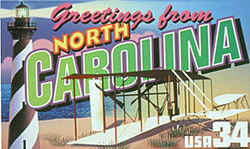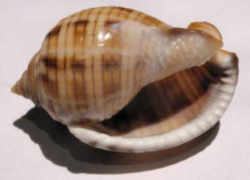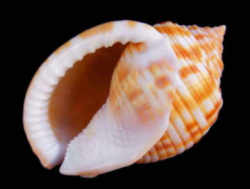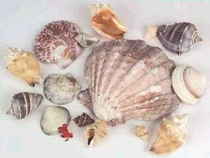
North Carolina Symbols
North Carolina State Shell
Scotch Bonnet

(Phalium granulatum)
Adopted in 1965
The General Assembly of 1965 designated the Scotch Bonnet, Phalium granulatum, (pronounced bonay) as the State Shell. (Session Laws, 1965, c. 681).
North Carolina State Shell: Scotch Bonnet

A pattern of squares and spiral bands resembling Scottish plaids, and a shape resembling a woolen cap worn by Scottish peasants, give this mollusk its name. It also led North Carolina to choose the Scotch bonnet as its state shell in 1965 in honor of its early Scottish settlers. With this designation, North Carolina became the first to adopt a state shell. The Scotch bonnet (pronounced bonay) and other helmet shells belong to the class of mollusks called gastropods, which have one shell. About 60 different kinds of bonnets exist throughout the world.
A colorful and beautifully shaped shell, the Scotch Bonnet is abundant in North Carolina coastal waters at depths between 500 and 200 feet. The best source of live specimens is from offshore commercial fishermen.
This shell is produced by a marine snail that lives in shallow water. Large and distinctive in its appearance, the scotch bonnet is china white to creamy in color with yellow to brown spiral bands. After the snail dies, its shell may be occupied by a hermit crab.
Nature's beauty leaves its imprint on this graceful shell in a pattern of pale brownish squares and spiral bands on a light yellow or whitish background. Beached shells bleached by the sun usually appear chalky white because of a loss of natural oils. The egg-shaped Scotch bonnet grows 2 to 4 inches high with females usually growing larger than males. This sturdy shell bears about five whorls, or secsections, with coiled grooves. The final and typically largest whorl- the body whorl- contains most of the animal's soft parts. The Scotch Bonnet develops a whorl and thick outer lip, resting during each stage of growth. When it begins to grow again, it absorbs the outer lip. Sometimes, especially in deep-water specimens, the outer lip is not completely absorbed, leaving a mark or scar on whorls of a mature shell. Sutures, or seams, between whorls appear subtle, yet distinct. A large opening called the aperture lies between a thick, toothed outer lip and a broad inner lip with small bumps at its base. The snail that grows inside the shell looks much like a typical garden snail with a large foot and a tube-like siphon for passing water and wastes. Eyes lie at the base of slender tentacles, and the mouth contains a tubular extension called a proboscis for feeding. Amarine snail, it grows around a pillar inside the shell called the columella that is protected by a shield-like wall.
North Carolina Law
The law designating Scotch bonnet as the official North Carolina state shell is found in the North Carolina General Statutes, Chapter 145 Section 145-4.
CHAPTER 145. State Symbols and Other Official Adoptions.
SECTION 145-4.
§ 145-4. State shell.
The Scotch bonnet is hereby adopted as the official State shell of the State of North Carolina. (1965, c. 681.)
Taxonomic Hierarchy: Scotch Bonnet
Kingdom: Animalia - Animal, animaux, animals
Subkingdom: Bilateria
Infrakingdom: Protostomia
Superphylum: Lophozoa
Phylum: Mollusca - mollusques, molusco, molluscs, mollusks
Class: Gastropoda Cuvier, 1797 - gastropods, slugs, snails, escargots, gasteropodes, limaces, caracol, caramujo, lesma
Order: Neotaenioglossa
Family: Cassidae Latreille, 1825
Genus: Phalium Link, 1807
Species: Phalium granulatum (Born, 1778) - Scotch bonnet







